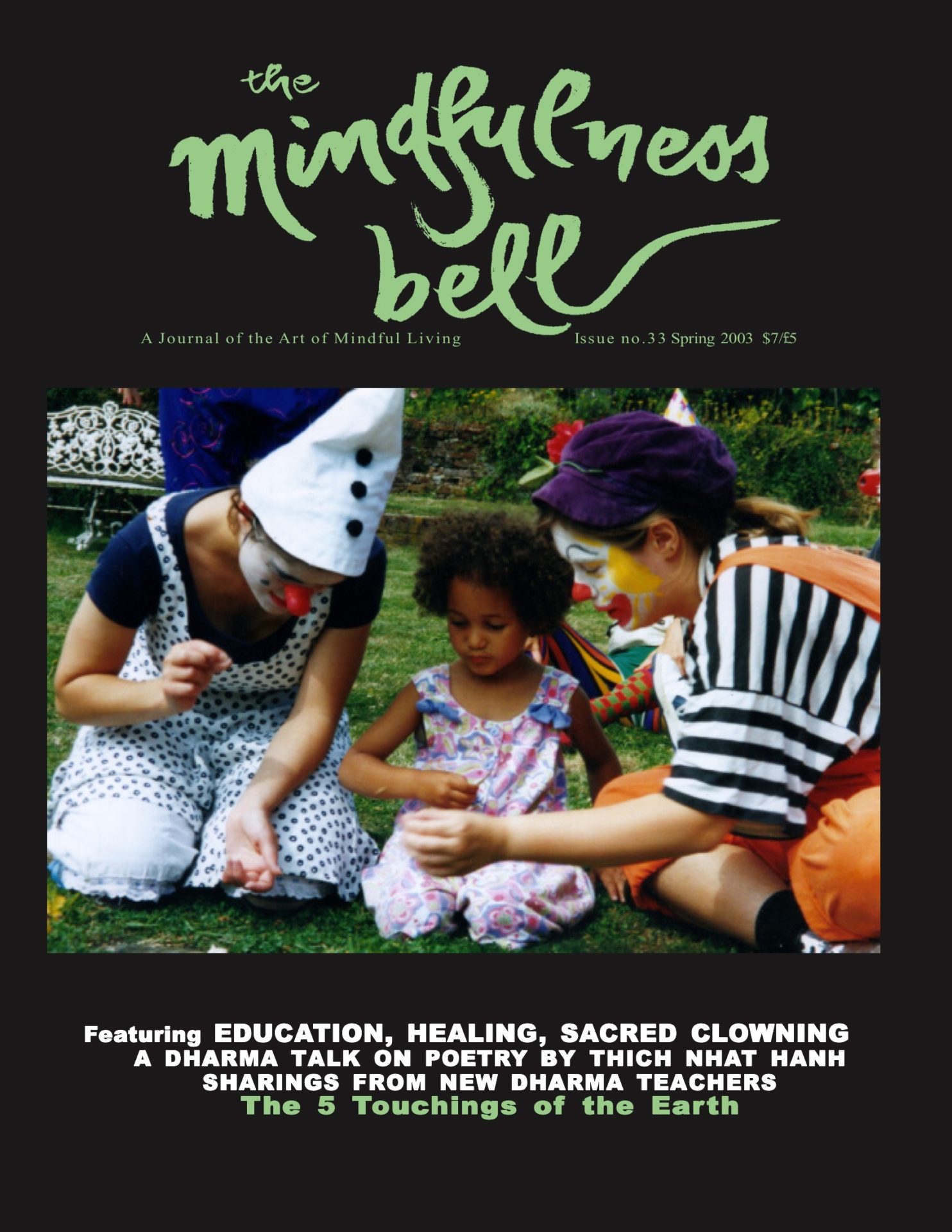An Interview with Didier Danthois
By Barbara Casey during the Hand of the Buddha Retreat in Plum Village in June 2002
Barbara: Didier, how did you create and develop the idea of sacred clowning?
Didier: For me the “sacred” added to clowning is a way to celebrate the eternal quality of our human nature, and ultimately, to share that eternal aspect through the art of clowning.
An Interview with Didier Danthois
By Barbara Casey during the Hand of the Buddha Retreat in Plum Village in June 2002
Barbara: Didier, how did you create and develop the idea of sacred clowning?
Didier: For me the “sacred” added to clowning is a way to celebrate the eternal quality of our human nature, and ultimately, to share that eternal aspect through the art of clowning.
Barbara: How does the sacred part express itself in the clowning?
Didier: It connects with the clowning because of the way we prepare, the way we tune into ourselves, where we come from with our clown. This work is not about acting. It is about coming home to the present moment. We are interested in touching the quality of this moment. For example, how you feel, how you are, just now, as you are sitting, touching the floor, a cushion next to you. What is around you, and between us as we speak? All those nuances of experience are moving through us in this moment; maybe the shyness
I feel as I speak with you, or my joy. To honor all those qualities as a shared reality, as a ground to inspire us into creativity. An authentic improvisation is born, just from being present, open, receptive; not from an act. You are here, I’m here, and I feel that, and from there, a dance can start to happen. Sacredness to me is connected to honoring that essence of coming home to ourselves and each other.
Doing nothing is the main point for me when I work with people. Sometimes I have people who have had years of drama training and I ask them to do nothing and it is very hard for them. To be on the stage and just be, with your heart open. Do nothing, just feel. Unless we can do that, we cannot touch the truth about our relationships, our true connection to space, to the universe. All performances or work we do with patients in health care settings is based on that attitude. Trusting, being in the now, listening, letting ourselves be touched, rather than coming with an idea to fill up the gap when nothing appears to be happening. True creativity can only come from silence, from not knowing.
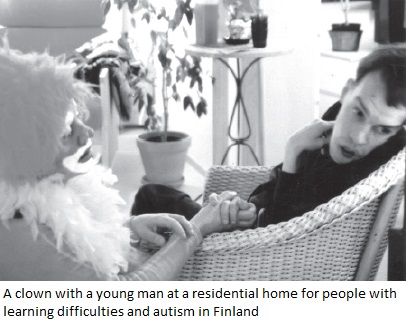
Barbara: So when you offer this, what is your hope? That people come into this space with you?
Didier: I would say I wish to meet people. I don’t hope that they meet me, because hope is an attitude which provokes certain reactions. We create an open space where we just intend to meet the other. And that means we might be rejected. If we meet our fears as they are, and don’t try to change the outside situation, or want something different, then there is the potential for transformation. In that attitude, we come to essence, by simply not expecting things to be a certain way, and engaging from a true emotional response to what is there.
And then, of course, we use our skills in movement to magnify what we feel. So we develop dance, we develop mime. We enter imagination and play mindfully. In mime, the essential point is to come to the essence, to the heart of a movement. We can come to essence through feeling, through being here now. So it’s another way to look, and that has been a great key in the way we work as sacred clowns.
This way of working came to me ten years ago, after working extensively with people with special needs. For eight years I worked with blind performers on stage, with people who had Downs syndrome and learning difficulties, people who are often considered to be unable to do anything. I worked with one completely blind lady, and in the show we had to cross the stage running. She saw nothing, and her hand was resting on my hand, and the weight of her hand was like a leaf. She had total trust. At one point we had to jump together, leaping across the stage. We could have run into the wall! I’ve really learned about trust from those students. They taught me so much. Working with them, putting performances together, rediscovering the true meaning of being present, not expecting something. They taught me how in putting the performance together, they were not bothered about the end product. I was, they were not! I went through a lot and over the years they showed me that actually each step is a gem, nothing is separate. Everything is part of the beauty unfolding.
I remember there was a beautiful man, about twenty years old, in a group of people with Downs syndrome. One day he shared a dream. And I took the whole group into creating the reality for his dream. The power of his dream was a teaching and a mystery, so we entered it. All the participants in the workshop created a magic story out of this dream. It was so moving. I was nearly crying by the end of it, it was pure, there was no ego. I did my best to have enough openness not to try to modify but to follow and serve that dream, to open and let go. These people took me back to what celebrates life and the eternal aspect of love and nature.

So how can we bring that quality to the population of supposedly “normal” people, like you and me? And that is where I look for the answers. What was the essence of that experience? Innocence, potency of feeling, presence, authenticity, very little thinking, and joy and fun. A lot of this attitude was coming from play. How can we resurrect play? How can we be in the present, how can we be in touch with our feelings? Then one day I discovered a man called Lex Van Someren who was teaching something called ‘The Dancing Clown.’ So I started training, and soon I was very involved in the humor of the clown and the ability to play with everything that creates it, which is your sadness, your joy, your depression, your wanting to hide behind the corner. All those qualities are not to be separated. The clown is about restoring the full picture. It is expressing opposite energies. One of the names for the clown in the North American Indian tradition is “contrary.” He has the ability to touch on what is not expressed, on the repressed, to bring back to life, to mirror to the society what has been forgotten.
Barbara: It’s like the court jester.
Didier: Yes. It is the same. The clown is to bring back what is left behind.
Barbara: Big job!
Didier: That’s a big job. So the courses we do, we reawaken that ability to get in touch with the present moment. Working with inner listening, rather than outer, and watching the breath, feeling the breath through the whole body. And I apply that literally to movement. If you want to expand your mind right to your fingertips or your toes, you can do that. And then we get in touch with beauty. Your movement becomes magic because you are opening your consciousness to touch the air, to tickle the air, with your fingertips, or your toes. Then wonder is there and also innocence. We are touching innocence, which means spontaneous, unprepared actions. Those movements are the result of inner listening, of bringing back the sense to their inner source.
Barbara: When you go to a hospital, when you enter that space, how do you help to create safety for those people? How do you connect? Do you begin to express what you feel in the room? I always had a fear of clowns because there is a spontaneity there and a call for interaction, but I didn’t feel safe because I didn’t know what their motive, their agenda was. How do you create safety?
Didier: Another aspect which we train to develop as part of mindfulness is compassion, to really feel the other as much as yourself, and to move into action in response to the other with care. We learn to sensitize that muscle by practicing compassion. Breathing in, dissolving your own resistance, your own blocks, your own fears. And breathing out, offering care to the other. We practice that for each other as a team of clowns, and then for the patients or audience. We practice this weeks in advance as part of daily warm-up, which means the clowns, the artists, already feel relieved of a lot of fear and feel more creativity, more ease, more love. Something has been prepared on the invisible level. We include the staff, the patients, the whole surrounding in our preparations.
I feel this is a very important part of the way we work. And many people feel quite inspired by this way of working because it brings more understanding, more openness from the people we share with, whether it’s a hospital, or a street improvisation.
It touches people. And we are able to share some of the values we’ve forgotten in our society, like silence, stillness, expressing true feelings. Being in places where normally nobody stops. We use simple things of nature to share our experience. We smell a flower, then offer it to someone. This art is about stopping in order to experience the here and now. Sometimes we go into slow motion. A group of five, six clowns in slow motion, walking next to each other. Traveling, but not going anywhere. Enjoying being the Fool, being aimless. This is what I call “Fool at Heart”, the Fool who expresses a response from his heart, or her heart.
Barbara: Tell me about how you work in teams.
Didier: We work in groups with street improvisation and in parks. A landscape of clowns comes together, relating to the space, celebrating nature. This summer we are having a gathering of about thirty clowns. We are working with a group of children in Germany, and are going to create a magical journey of clowns through a garden. So we will lead the children into different mime-clown scenes, really connecting to nature. That’s one example of what we do together.
Another aspect of the work is stage performance. Every year we have a retreat in Scotland, and we offer a performance in a Tibetan monastery there. We offer a whole week of training at the end of the retreat and we also have a performance with the monastics. It’s so beautiful!
We also have a more committed aspect of clown training for the work we do in hospitals. It requires being very grounded in meditation, and true motivation to want to share something from your heart. The nurses are often over-worked and very stressed. You come as a clown, with your joy, playing music, and maybe invite a patient to sing, or play, opening the joy muscle. I have worked with groups of nurses, and through that I have realized how much compassion they have, but so often, they didn’t have enough support to help them integrate challenging experiences. After nursing a dying patient, they might have to rush immediately to the next one. No space, no sharing time, never. So slowly, something tightens in their heart. But of course, their compassion is still there, underneath all the stress. As a result, the nurses might sometimes feel annoyed with the clowns, or at other times relieved to see them.
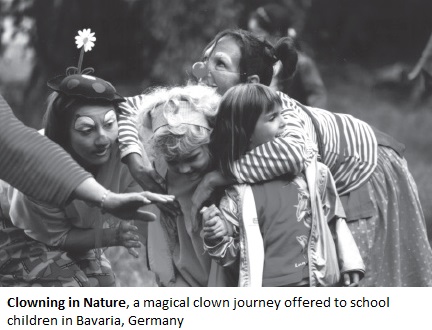
Barbara: How do you deal with that?
Didier: I’m a true Westerner, very independent, and I have a lot to learn about being part of an organism. That’s why I’m here in this retreat, and I have a lot of pain to clear. My family and my background never gave me a positive experience of being part of a group. And now I realize the next step for this work has to be in a Sangha, so we can be supported in our values. The teaching of this three-week retreat is just like pouring honey into my brain and my heart, and I’m clearing up so much pain of never having lived in a true family. Here we have a true family. Thay inspires me so much about Sangha building, and how we can celebrate the sacred, the true values of human life. But as soon as we touch those wonderful golden aspects of life, we release a whole cloud of suffering that’s been there for years and years, so we are still very much beginners on the path. How can we hold the sacred view in a society that is not seeing it? That is the challenge. That is why I am here.
Barbara: How many clowns do you work with?
Didier: There are eighteen trained clowns. Clown Care & Co. is composed of two groups in England, (in London and Bristol), and there are other Sacred Clown groups emerging in Holland, and Germany, (in Munich and Frankfurt).
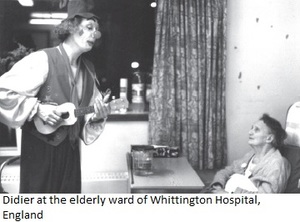
Barbara: Didier, can you give me a specific example of seeing someone transformed or touched when you were clowning?
Didier: We’ve been working with the elderly in a Jewish center, with people between 65 and 100 years of age. It’s a big place, 300 residents, and we’ve been working with teams of clowns and it has been quite beautiful. The residents often say they are bored, watching TV all the time. Some are depressed, waiting for death not having much hope for anything else. Discretely we find a way, maybe over two weeks, to turn off the television. Then three, or four, of us may just mime how we see the residents we are visiting. I might sit there and wait a bit, copying their posture, just being there, breathing, making some eye contact, Not expecting anything in particular – the whole work of clown care is not to expect, but to trust, and doing nothing is doing everything, just being there. And then we can just make a little movement, and very soon there’s a kind of mirroring happening. They start to move, I will start to move slowly, and I start to play some music, singing an old Jewish song they have known in their childhood. We hum the melody, and they start to sing the words. And as they sing the words, some joy comes into their body, and we encourage a little movement, just connecting to their neighbor, letting go of their feelings of isolation. So it builds up slowly from things that are meaningful to them.
We’ve had many who started to sing with us so loudly and full of energy. We might have two clowns who start to dance in the middle, softly, to the music. If someone is totally withdrawn, which can happen particularly with dementia, we might just start copying them, or for example touch their hand, to bring back the mind into the body. We have to feel how far we can go without disturbing their sense of security. So that’s how we work, we invite slowly, and we engage, in a very careful way, with music, mime, mirroring their feelings, in a true way until we open the door for a possible exchange.
Our mind/heart is a mirror. As you become a mirror, you are remembering yourself, especially when you are old and a bit lost in your mind. Here you are, and you’re fine as you are. And this true meeting is a stepping stone for playing creatively. Then we can start to relate to the invisible, as we touch empty space, letting an expansion arise from the meeting. It’s to expand our mind to a possibility that there is something more than you and me here. This is also the role of the clown. We are entering the invisible. As we enter this realm, something happens in the feeling, in the mind, and it has surprising qualities, it can transform. We start to relate to the invisible.
Barbara: That really helps me understand how you work and how the human process happens, the gift of being together, and the gift of presence. Didier, is there anything that you could offer to the rest of us, of how we could bring this sense of play into our lives, in our interactions with others?
Didier: What touches me so much is looking at beauty. What is beauty? And where does beauty come from? If you move and there’s beauty in your movement, anybody can be touched. Beauty is simply bringing the breath into the movement, and letting ourselves be touched. We often say we have to do something to express ourselves, but actually, to have an attitude of listening and letting ourselves be touched by what is, that is real beauty. The air as you move, the floor under your feet, all those things are the ground for beauty, a kind of beauty that gives joy, and costs nothing. What is art? Art is being simple. Like William Blake says;
To see a world in a grain of sand
And a heaven in a wild flower,
Hold infinity in the palm of your hand
And eternity in an hour.

It is there. And if we can just really enjoy a flower, or a little shadow on the floor, or some dust in the air, you can enter it. We are very free already when we bring our minds to the smallest things. Developing mindfulness into an art form is the most wonderful gift. The clown is a master at coming back to being
truly human, embracing the sadness and the joy, so they unite and become one. This is the full spectrum, the full rainbow, sadness and joy, there is a quality of reverence in that experience, and it also becomes a potential for play. It is very simple. It is the practice of coming home, being touched and touching. In my performances I don’t work with things completely set, there are just little landmarks, and between them I connect with the audience. The audience is creating the performance with me. We are engaging and sharing a creative moment together, and it’s a mystery. And if we can hold that mystery, then we have true magic. The interaction of opening the space and holding it together, the not-knowing, is really a beautiful interconnection.
Barbara: I’ve been touched, by you allowing yourself to be touched.
Didier: Yes! Right. To not know, and hold it there. You know, hold it right now, just here — I don’t know what I am going to tell you, I’ve lost the track of it.
Barbara: [laughs]
Didier: Just enjoy it!
Barbara: Right!
Didier: You know, if I can just enjoy it, it’s okay.
Barbara: Right, right. It’s interesting how much discomfort there is, in that moment, for most of us.
Didier: Exactly. In that moment, I’ve lost the track. I can panic. Or I can enjoy it. Then we stay together and just trust each other. If you are on stage, with an audience before you, and you fill up the gap, then at that moment you are truly lost. If you are lost, you have also lost your audience. You have lost the inter-dependence. So it’s very important to not panic, but rather to rest there, and not judge the experience.
Instead of performing, we learn to be in the moment, and when nothing is there, just breathe! As soon as you have this attitude as the ground, you are never lost. You are always free, and you are always in total connection with your surrounding and the people present.
[plane flies overhead, making a lot of noise.]
I just lost what I was saying then, and I felt, okay, just felt it, [exhaling long], and I didn’t lose you. But in that moment, it would be easy to fill up the gap with doing.
Barbara: Right.
Didier: This is where we lose track.
Barbara: And especially, if you had kept going with what you were saying, ignoring that sound, you would have lost me, because it’s all happening right there, and we were in it together.
Didier: Yes.
Barbara: – and we need to be authentic with it.
Didier: Exactly.
Barbara: I’m going to try that. When I lose my train of thought, instead of trying to get it back, I’m going to enjoy that moment, that place.
Didier: Creativity is never lost then, because with this attitude, we will be touched, if we remember to trust.
Barbara: Sometimes losing your train of thought is a very good thing, because it takes you back into your store consciousness. And when you feel that the ground underneath you drops away, what you feel is where you really are—you’re coming from a much more authentic place then, a place in the moment.
Didier: Yes, exactly. It is a very important key. And often with art, we are frightened to become, to do, art. We are frightened to dance, especially in the West, everybody is more or less terrified to express themselves. At school, you’re asked to do a drawing, you have half an hour, and you try to do it right, yeah? You have never been told how to touch the magic. I never learned those things at school. I learned the opposite. I was beaten up at school.
Barbara: You just learned how to be judged.
Didier: Exactly. And also to judge myself. So one of the basic things to re-learn is to trust, and in doing nothing, we can let ourselves be touched. To touch the magic is entering that space of letting ourselves be an instrument. This is where art is born, I think true art. And if we can share some of our feelings in this way, in a park, in the middle of nowhere, this is very important. In the middle of a British railway station, there are three clowns, expressing just that. And very quickly, you have many people who stop, because they have been waiting for something to stop them for a long time. The clowns do slow motion mime, and it’s very beautiful to watch, because it’s not a movement from an idea. It’s a movement coming from being very present. It can touch deeply.
I’ve been very involved with teachings from the East. And now I am feeling and exploring where our roots are for mindfulness in the West. Where is it hidden, that understanding of being in the present moment? The archetype of the Fool is a very important Western archetype. Jesus was a Fool. There is so much of that Fool quality in his teachings. Many times here in Plum Village, when we are eating together in mindfulness, I feel that I’m eating with Jesus. It comes not as a thought, it comes like a feeling or a memory. To touch some essence of the Fool is very important. The clown is born from that. The role of the Fool in spirit as an archetype is extremely important, in resurrecting simplicity and joy, the pleasure of being in the moment, touching life, all of nature, in a very simple way.
Barbara: I was a fairly happy child and fairly happy adult, and then at a certain point I started feeling like I lost my playfulness, that a lot of my life was spent doing things I didn’t want to do, and I wasn’t very happy. I wasn’t seriously unhappy, it was just that a lot of what I was doing was not really play, not really fun. And I started looking at that. Where did that happen? Why did that happen? And I feel that today you have led me back into exploring play and being in a group, a Sangha, that plays together. And I think that the Fool is the one who has the ability to stop everything and play. That’s so needed because we have this idea that when we grow up, things have to be hard, and we have to work all the time, and we have to let go of childish things, and so we lose ourselves.
Didier: Yeah! We lose the sense of play.
Barbara: Yeah! And we lose our heart, we lose our joy. And it’s very sad when there are children who have lost that.
Didier: It’s very sad. It’s a big concern I have about play and children, and what is happening to them. I mean, what we are doing? We are taking away all drama in school, all physical education, and in England, they are selling playgrounds because they want the space to build buildings. This is absolutely mad. And the computer world has taken over the children’s world. They play not with people, they play with machines and in the computer games they learn to kill each other. This is very serious, if we realize that play is the beginning of spiritual understanding, the root is starting there when a child plays with another, in trust and not knowing.
Play, to my mind, is bigger than the individual. It is taking us on a journey of creativity. It is the first step in a perception of something beyond my individual self. And we learn to respond to emotions, to each other as we play. If we don’t let the children play in this way, what are we going to have in fifteen years? This is very serious. I have put together a questionnaire for school teachers to express what they feel is happening with our children, because the curriculum has become entirely academic.
We must become aware of the importance of play for the sake of the children. This is really the focus I have now for the work, to really bring awareness to the importance of play, as the birthplace for spiritual understanding.
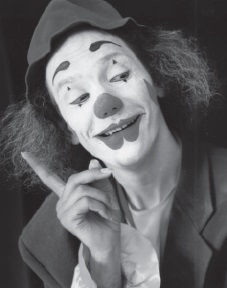
Didier Danthois first trained in clowning and circus skills twenty years ago at the Fratellini Circus School in Paris. He studied Expressive Dance, and performed with Amici Dance Theatre Dance Company for five years. He is also a certified Biodynamic Psychotherapist and group facilitator. He trained in clowning with Lex Van Someren. Didier has been inspired by the teachings of the Buddha for the last ten years, first through his root teacher Sogyal Rinpoche, and then by Zen Master Thich Nhat Hanh. He works towards creating an art which celebrates the beauty of authenticity, compassion and the interdependence of all things, and all people. Didier is the founder of Fool at Heart, School of Sacred Clowning, and teaches, performs and directs in England and abroad. He is presently involved in establishing ‘ClownCare & Co.’, an organization bringing Sacred Clowning into healthcare settings.
For future events, contact Didier at 32 Rosemary Avenue, London N3 2QN England Tel: 020 8343 0255 E-mail: ScSacredClowning@aol.com
Barbara Casey, True Spiritual Communication, is a managing editor for the Mindfulness Bell.

